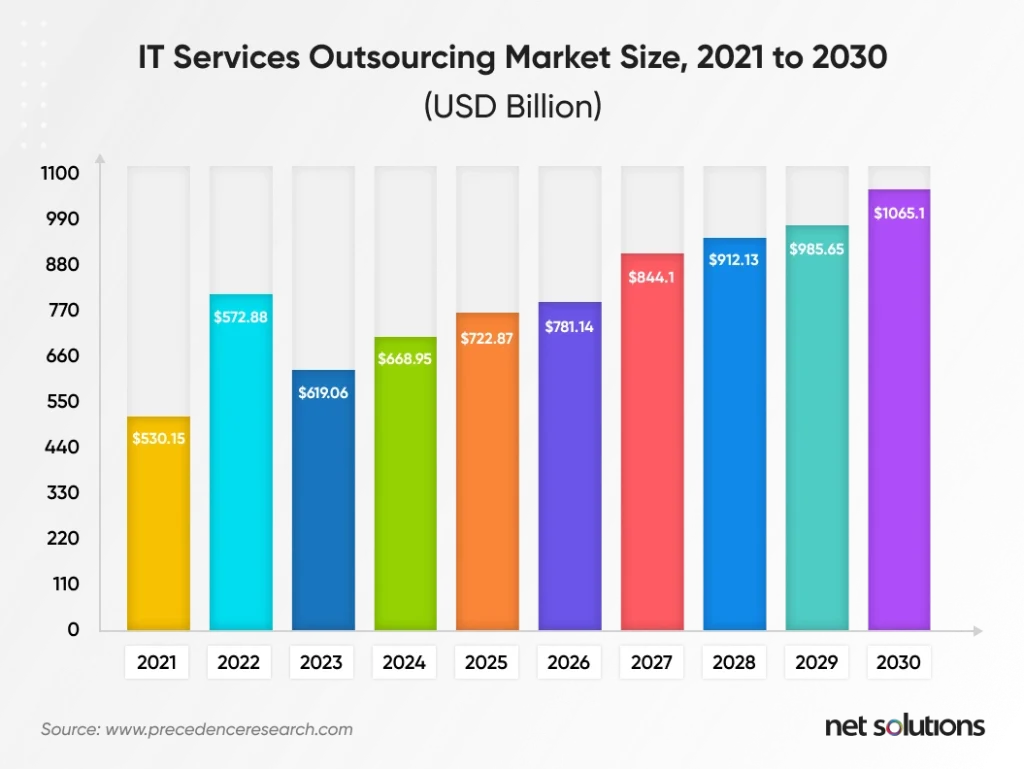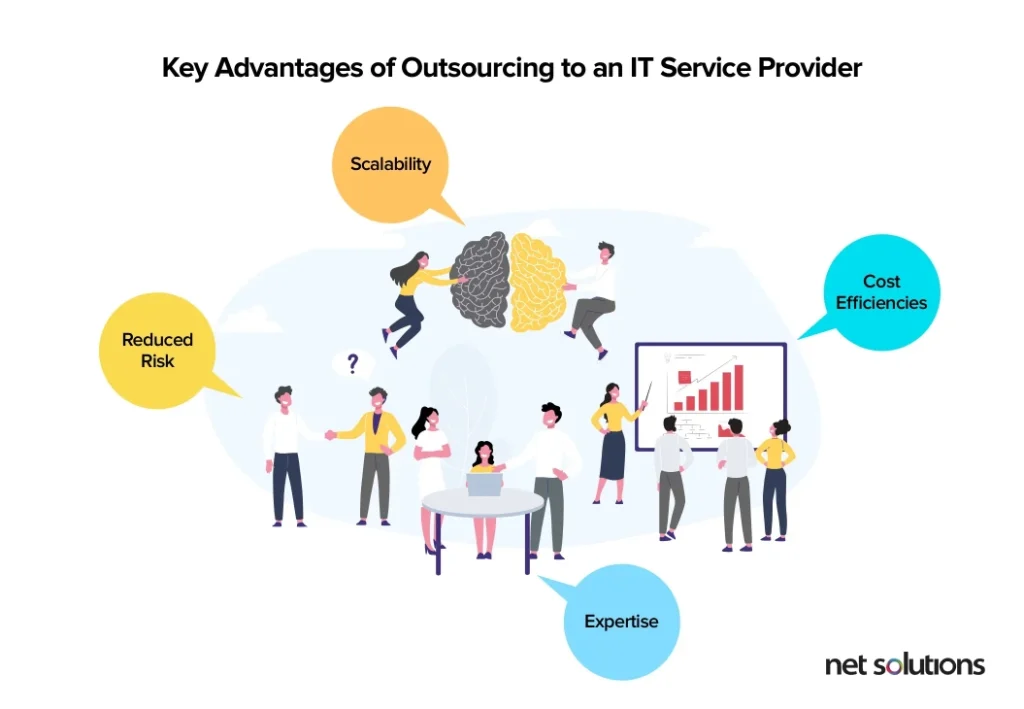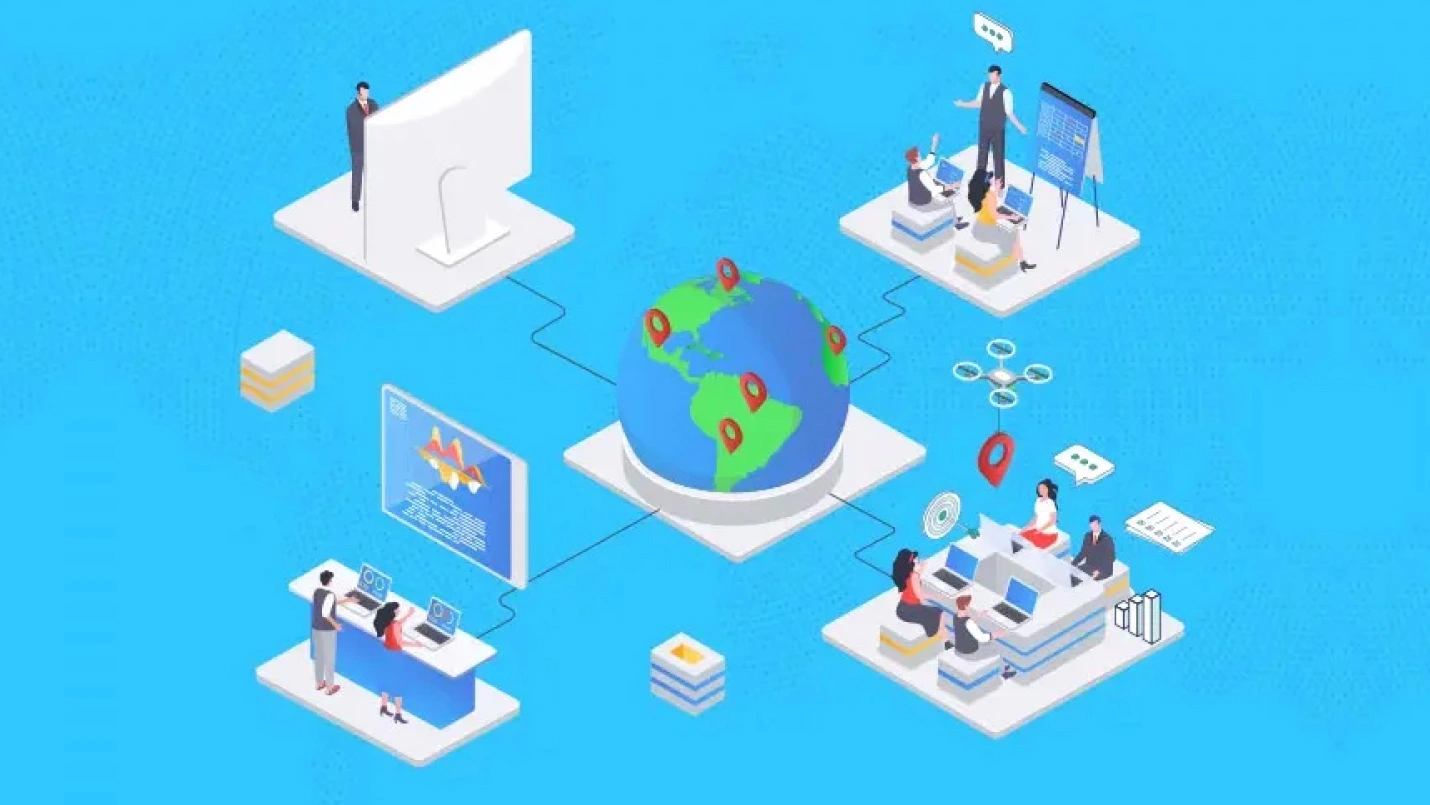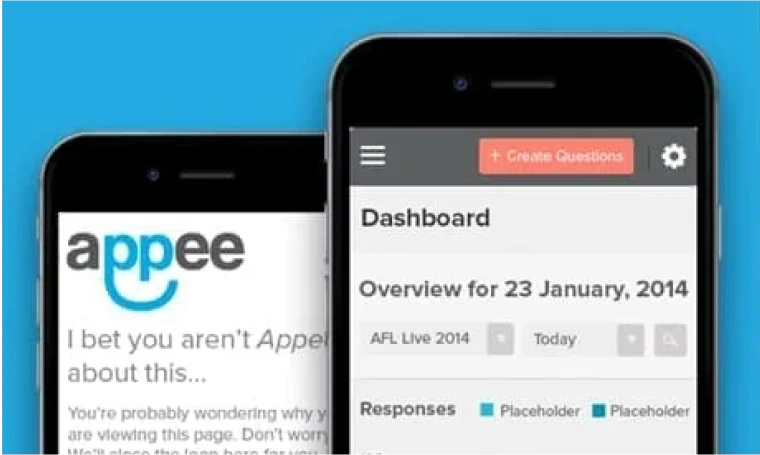Discover the most important aspects while selecting the best IT outsourcing partner. Our blog defines your outsourcing requirements, comprehends alternative outsourcing models, evaluates security measures, and develops long-term collaborations. This blog will walk you through making informed decisions and maximizing the advantages of IT outsourcing, whether you’re looking for cost savings, scalability, expertise, or risk reduction.
Software development outsourcing allows businesses to tap into a flexible team of creative thinkers, designers, and developers with diverse backgrounds able to design and build the right digital product for their needs.
The efficiency and innovation that comes from having access to a comprehensive set of IT services have led to significant growth in the outsourced IT market, which is anticipated to reach USD 937.6 billion by 2027.

Why Choose an IT Outsourcing Service?
One of the primary drivers for software development outsourcing (including digital product development) is gaining access to skill sets that are unavailable within the organization — or at least not at the scale businesses need them to be.
35% of organizations turn to outsourcing for innovation, with additional benefits coming from cost savings, reduced capacity issues, and the freedom to focus on core business. Working with a software development outsourcing service helps companies align their organization with a flexible talent pool of people, skills, and services, empowering them to transform their business outcomes.

Key advantages of software development outsourcing:
- Cost efficiencies: Software development outsourcing allows organizations to realize cost savings via access to specialized experience without the burdensome fixed costs of a full-time employee or the time-intensive and high-priced option of re-training current employees for new IT skills.
- Scalability: Outsourcing partners can scale when companies need them to, which allows for rapid project initiation and ensures faster time-to-market.
- Expertise: Companies can access skills “on-demand,” allowing them to expand their team to include broader knowledge and tap into state-of-the-art technologies quickly.
- Reduced risk: With the rapid pace of change in the marketplace, responsiveness is key during the development phase. Businesses can scale their team up or down if the business environment or the requirements change (as we saw with COVID-19).
Outsourced partners also have the workforce to meet tight deadlines and are accustomed to working within budgets that are much less flexible with full-time, salaried employees.
These benefits of outsourcing can influence organizations to make the switch; however, finding the ideal partner is imperative.

We respect your privacy. Your information is safe.
The 7-Step IT Vendor Selection Process

To perfectly manage a software development vendor, an enterprise needs a set of principles and processes to increase the engagement’s profitability. However, hiring an IT vendor for the first time requires extensive planning. Many software development outsourcing companies have well-designed websites and claim to have well-known brands on their lists of previous customers. However, all that glitters is not gold. One needs a viable vendor selection framework to filter the best ones. Here is a plan to help identify the best fit from the many IT vendor companies.
Step 1: Analyzing the business requirements
Hiring a software development outsourcing partner is a big business decision that must be an informed one. Therefore, before reaching out to partners and interviewing potential vendors, the business should clarify its part of the story by thoroughly analyzing their requirements and needs. This is one of the essential steps in the IT vendor selection process.
Organizations should list who might have an opinion that can influence their decision about the IT vendor selection process. Next, define the technical, business, and functional requirements for which they plan to hire a vendor. Then, share these documents with the company stakeholders and decision-makers to seek their opinions.
We recommend including the following points in the required documents:
1. Type of software the company plans to build
When planning to hire an IT vendor to build a software product that is desired to perform a specific task or function, describe it in detail. What is the goal behind hiring an IT vendor? Is it building a custom app, a training simulator, an IoT platform, or something else? Consider listing its functions and business needs in detail.
2. Note the tech stack the company has specific expertise with
Enterprises dealing with software projects may have a separate list of technologies they are familiar with and would like to use to reach the desired solution. If they already have an in-house team working on the same software and plan to outsource any specific panel, their team or developers may have some good suggestions for the already integrated tech stack. List all of them in the document and let others share their opinions.
3. Estimated deadlines
In the software development world, time is money. The IT vendor’s team will propose timelines related to the delivery, but companies must estimate when they need the initial delivery.
4. Other requirements
The company stakeholders may differ on hiring developers with specific affiliations when considering long-term relationships and post-release interactions. This includes logistical considerations such as technical support being available during hours complementary to the business hours of operation.
Step 2: Research the market and filter vendors
Once all the requirements are known and the company stakeholders are approved, it is time to search for potential IT vendors. The following resources will help in this process:
- Search out B2B network sites of tech companies like Clutch or Good Firms and look for software development outsourcing vendors with good ratings and reviews.
- Refer to industry publications. Gartner and Forrester provide research papers in which they list market leaders.
- Ask friends or post a job on LinkedIn to seek attention from potential IT vendors. Use LinkedIn to see who else has endorsed the particular vendor for services similar to your needs.
Step 3: Use agile methodologies in the organization’s development process
The only way to survive in the present market is by accommodating customers’ ever-changing requirements. The organization must utilize Agile methodologies to serve the continuously changing customer efficiently.
Agile methodologies offer a highly collaborative environment and give quick results. To stand out as a leader, prefer leveraging a partner who follows Agile methods to adapt to a customer’s changing requirements quickly.
Step 4: Request for Proposals (RFP)
Now that the business needs are known, and a list of suitable IT partners has been created, it is time to test and evaluate the assumptions. It is time to request an RFP (Request for Proposal) or RFQ (Request for Quotation) to send to potential software development outsourcing partners.
An RFP is created if the desired service, quality, or final result differs for each vendor likely to respond. On the other hand, an RFQ is utilized to ask for quotations for simple services with no chance for desired service or product differentiation between responding vendors. Here are some objectives behind creating RFQ and RFP:
- Getting detailed proposals from IT vendors showcasing their domain knowledge and expertise.
- Negotiating the best deal possible and identifying the vendor best suited for the company’s needs.
- Setting clear goals, responsibilities, and constraints to maintain a healthy future relationship with the software development outsourcing partner.
Companies should create these documents to clearly describe their business goals and present their needs to the vendor. These documents’ main points will differ depending on their company type. However, there are a few sections that every RFP and RFQ document must have, including –
- Submission details
- Business overview and goals,
- Detailed specifications
- Business constraints
- Terms and conditions,
- Selection criteria
After creating such a document, send suitable copies to each vendor. Also, include the contact information in the document so the vendor can reach out for any query.
Step 5: Analyze and evaluate responses
The next step in selecting the right software development outsourcing partner is analyzing the vendor responses and selecting those who understand the business needs. A spreadsheet can be prepared to evaluate and compare the vendors. Specify different criteria for selection and rate each vendor with a color code for each criterion. For example, green for the best responses, red for the bad, and orange for the average.
Step 6: Schedule demos and interviews
Request the shortlisted software development outsourcing vendors to demo the technology solutions they are proposing. This will help predict their expertise and how companies can integrate their proposed solutions into their tech ecosystem.
Another benefit of scheduling demos is that they help test the proposed solutions before investing. This helps determine how to meet the stakeholder’s expectations and business needs. Therefore, companies should arrange demos before selecting and finalizing the deal with a vendor.
A few queries should be addressed during this outsourcing partner selection process stage:
- Does the proposed solution meet the organization’s user’s needs?
- Is the tech team aware of the proposed technology?
- What risks are involved in integrating the proposed tech into the business processes?
- Do the company stakeholders think the proposed tech solutions are economically viable?
- How was the experience of the demo – any bugs or bad UX realized by the team?
Step 7: Negotiate the contract
Once everything looks fine, companies can close an excellent deal for both parties. This requires good negotiation skills, so involving people from the sales and finance departments is advised before settling the numbers.
After deciding the total cost of the partnership, make payment milestones so that the final payment should be a substantial amount of the full payment. The final payment should be made only after the work has been fully completed and tested.
If there is a legal department within the organization, get them to review all contract clauses before finalizing the deal. It may take a few days; however, it is a crucial step to make sure everything falls in the right place. As an IT leader, one may need more expertise to avoid all hidden clauses in the deal, which could create problems for the enterprise later in the process.
Tips to Make Your Outsourced Project a Success
Organizations should look for a partner who wants to do more than just build the product; the ideal partner will want to work alongside the organization to elevate their brand in the marketplace in the long term. However, like any relationship, the success of the outsourced project is a two-way street. Help the project succeed with these tips:
- Define the goals clearly
- Conduct feasibility studies and market research
- Choose a provider in a similar time zone (look for satellite office options)
- Check-in regularly for progress updates and feedback
- Choose a provider focused on iterative development (Agile and DevOps)
- Choose a provider who can meet the compliance requirements without delay, providing confidence their processes are already secure
Understanding the Software Development Outsourcing Landscape
Let us help you with an in-depth analysis of the current state of the software development outsourcing industry, the trends and advancements shaping the outsourcing landscape, and the role of software development outsourcing in digital transformation.
Current state of the software development outsourcing industry
The software development outsourcing industry is experiencing a significant upward trajectory. The revenue in the segment of software development outsourcing may reach US$430.50bn in 2023, and this growth can result from several key factors.
Outsourcing has become a global phenomenon, with businesses engaging outsourced partners worldwide. This reach enables enterprises to capitalize on time zone variances, allowing round-the-clock productivity and speedier project delivery. It also provides access to various cultural viewpoints, which can stimulate problem-solving ingenuity and creativity.
Trends and advancements in the software development outsourcing industry
The outsourcing IT industry is witnessing several notable trends and advancements shaping how businesses approach outsourcing engagements. These trends include –
- Embracing emerging technologies
- Agile and DevOps practices
- Cloud computing and Hybrid IT
- Security and compliance focus
- Industry-specific expertise
- Remote workforce enablement
- Focus on innovation and value-added services
Role of software development outsourcing in digital transformation
Outsourcing plays a crucial role in businesses’ digital transformation journey. It enables organizations to leverage external expertise, specialized skills, and advanced technologies to accelerate their digital initiatives and achieve strategic objectives. The key roles of outsourcing in digital transformation include –
- Access to specialized skills and expertise
- Flexibility and scalability
- Accelerated time-to-market
- Cost optimization
- Focus on core competencies
- Innovation and Collaboration
Determining Your Software Development Outsourcing Needs
When considering outsourcing, it’s crucial to determine your specific needs and align them with your business objectives. Here are vital factors to consider:
1. Assess your business objectives
Start by estimating your overall business objectives and how software development outsourcing can contribute to achieving them. Identify the specific areas of your IT operations or projects that can benefit from outsourcing. Determine whether your goals include cost optimization, accessing specialized skills, improving efficiency, accelerating time-to-market, or driving innovation.
2. Evaluate project complexity
Analyze the complexity of the projects or tasks you plan to outsource. Consider the level of expertise required, the technical challenges involved, and the potential risks associated with the project. Assess whether outsourcing providers have the experience and capabilities to handle your specific requirements effectively.
3. Analyze costs
Evaluate the costs associated with outsourcing versus keeping the tasks in-house. Consider labor costs, infrastructure investments, recruitment expenses, and ongoing maintenance expenses. Compare these costs with the pricing models and service packages offered by outsourcing providers to determine the cost-effectiveness of outsourcing.
4. Assess project timelines
Assess whether outsourcing can help accelerate project delivery by leveraging the expertise and resources of outsourcing providers. Evaluate the availability and capacity of software development outsourcing partners to ensure they can meet your project timelines effectively.
5. Consider risk management
Evaluate the potential risks associated with outsourcing. Estimate the risks related to data security, intellectual property protection, compliance, and vendor reliability. Seek transparency from outsourcing providers regarding their security protocols, certifications, and risk mitigation strategies. Additionally, consider their track record, client references, and reputation in the industry to gauge their reliability and risk management capabilities.
Different Types of Software Development Outsourcing Models
There are various models to choose from when considering outsourcing. Each model offers unique advantages and considerations. Here are the different outsourcing models to consider:
1. Onshore software development outsourcing
Onshore or domestic outsourcing involves partnering with service providers within your business’s country or geographic region. This model offers benefits such as:
- Proximity and time zone alignment,
- Cultural and language affinity,
- Regulatory compliance
However, it’s essential to consider that onshore outsourcing may have higher labor costs than other models, impacting overall project expenses.
2. Nearshore outsourcing
Nearshore software development outsourcing involves partnering with service providers in neighboring or nearby countries, typically within the same region or continent. This model offers benefits:
- Proximity and time zone convenience,
- Cost efficiency,
- Cultural and language proximity
3. Offshore outsourcing
Offshore outsourcing involves partnering with service providers in a different country or geographic region, often in a distant location. This model offers benefits such as:
- Cost Savings
- 24/7 Operations
- Scalability and flexibility
However, offshore software development outsourcing may present challenges related to cultural differences, language barriers, and the need for effective communication and coordination across different time zones.
4. Hybrid outsourcing
Hybrid outsourcing combines multiple models to create a customized approach that best suits your business needs. This model allows for a blend of onshore, nearshore, and offshore resources based on project requirements. Benefits of hybrid outsourcing include:
- Optimal resource allocation
- Flexibility and scalability
- Risk mitigation
What to Look for in a Software Development Outsourcing Partner?
There are many creative agencies focused on design and numerous outsourcing IT service companies that can deliver a project. Still, only some combine these into a product development mindset that can turn ideas into optimal outcomes.
It is crucial to find a partner with a product development mindset who is detail oriented and sensitive to each unique client’s needs rather than just focused on finishing the project and moving on.
A software development outsourcing partner with a product development mindset looks at outcome instead of output. This shift in thinking focuses on developing the right product for the company’s needs. One wants an experienced partner who brings the best possible processes and expertise from the discovery phase to development.
When selecting the right outsourcing partner, bigger isn’t always better. Finding the right partner for a business should focus on fit. When deciding if a partner is suitable for a specific business, key factors include:
1. An established track record
- Look for a provider with an established reputation specific to the organization’s niche.
- Seek out strategic, long-term partnerships
- Test-drive digital products
- Speak with references who have outsourced similar projects to the partner.
2. Broad technical skills
There is no one-size-fits-all solution for product development, so looking for a partner with published technical expertise in multiple areas is beneficial. This includes platforms, mobile, web, databases, DevOps, video, machine learning / AI, Cloud, CRM, and analytics.
3. Agile processes
Look for a partner leveraging Scrum-based agile development methodology to ensure the partner continuously incorporates feedback to avoid costly reworks. This iterative process allows measurement, testing, and scaling to confirm the results align with the business objectives.
4. A people-first approach
Designing the right product begins with one-to-one attention to understand the organization’s needs and document the project’s scope. The ideal partner will establish preferred communication channels and create a product roadmap for how often the company wants to be updated.
The right outsourcing partner is dedicated to helping companies to succeed and grow, no matter the size or scope of the project or if it will have ever-evolving needs.
Net Solutions is a strategic software development company that unites creative design thinking with agile methodologies under one expert roof. Founded in 2000, Net Solutions creates award-winning transformative digital products & platforms for startups and enterprises worldwide.
SOAQ collaborated with Net Solutions, a software development outsourcing firm, to create a bespoke software solution for workforce management issues. Net Solutions’ collaborated extensively with SOAQ to understand their specific demands, pain spots, and business goals.
Net Solutions created and implemented a workforce management system that automates shift scheduling, resource allocation, and job tracking using a collaborative approach. The solution smoothly connected with SOAQ’s existing infrastructure and delivered real-time insights and analytics to maximize resource use and operational efficiency.
We take a 360° view of your brand to chart the optimal course for revenue- and growth-driving digital products and platforms, including:
- UX strategy and product prototyping
- Usability testing & validation
- eCommerce strategy and optimization
- Lean, agile product development
- Data analytics, visualization, and digital customer experience strategy & insights
- Legacy IT modernization and digital transformation services
Frequently Asked Questions
Assess your business goals, project complexity, required skill sets, and resource availability. Consider factors such as cost-efficiency, scalability, expertise, and reduced risk. Outsourcing may be a viable solution if you need more in-house resources or specialized skills or need to focus on core business functions.
Assess the vendor’s security measures, such as data encryption, access controls, and compliance with regulations like GDPR or HIPAA. Look for certifications and protocols that demonstrate their commitment to data security. Ensure clear agreements and confidentiality clauses are in place.
Cultural compatibility can significantly impact collaboration and project success. Aligning values, communication styles, and work culture can foster better understanding and teamwork. Assess the vendor’s cultural fit, responsiveness, and language proficiency to ensure effective collaboration.
Foster trust and effective communication through regular interactions. Establish clear expectations and performance evaluation criteria. Encourage open and transparent communication channels and promote mutual growth and success.




